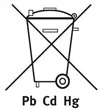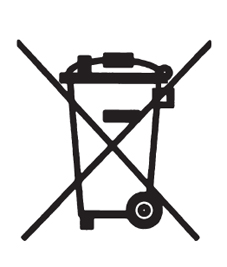Battery disposal
A. Information on battery disposal
In connection with the sale of batteries or the delivery of devices containing batteries, we are obliged to inform you of the following:
Batteries contain valuable raw materials which, although harmful to the environment, can be recycled. Used batteries must therefore not be disposed of with normal household waste, but must be disposed of separately.
As the end user, you are legally obliged to return used batteries. You can return used batteries that we stock or have stocked as new batteries free of charge to our dispatch warehouse (Lobigo GmbH, Im Tälchen 12a, D-66976 Rodalben).
Alternatively, end-users can also return used batteries to municipal collection points or recycling centres or wherever batteries/rechargeable batteries are sold.
The symbols shown on the batteries have the following meaning:

The symbol of the crossed-out dustbin means that the battery must not be placed in the household waste.
Pb = Battery contains more than 0.004 mass percent lead.
Cd = Battery contains more than 0.002 mass percent cadmium.
Hg = Battery contains more than 0.002 mass percent mercury.
Please observe the above instructions for environmentally sound disposal.
B. Electrical and Electronic Equipment - Information for Private Households
The Electrical and Electronic Equipment Act (ElektroG) contains a large number of requirements for the handling of electrical and electronic equipment. The most important ones are summarised here.
1 Separate collection of old appliances
Electrical and electronic equipment that has become waste is referred to as WEEE. Owners of WEEE must dispose of it separately from unsorted municipal waste. In particular, WEEE does not belong in household waste, but in special collection and return systems. 2.
2 Batteries, rechargeable batteries and lamps
Owners of WEEE must, as a rule, separate spent batteries and accumulators that are not enclosed in the WEEE, as well as lamps that can be removed from the WEEE without damaging it, from the WEEE before handing it in at a collection point. This does not apply if WEEE is prepared for re-use with the involvement of a public waste management authority.
3 Options for the return of WEEE
Owners of WEEE from private households can return it free of charge to the collection points of the public waste management authorities or to the take-back points set up by manufacturers or distributors in accordance with the ElektroG. You can find out about a take-back point near you at: www.take-e-back.de.
Shops with a sales area of at least 400 m² for electrical and electronic equipment as well as those grocery shops with a total sales area of at least 800 m² which offer electrical and electronic equipment several times a year or on a permanent basis and make it available on the market are obliged to take it back. This also applies to distribution using means of distance communication if the storage and dispatch areas for EEE are at least 400 m² or the total storage and dispatch areas are at least 800 m². Distance sellers who are obliged to take back electrical and electronic equipment shall in principle ensure take-back by providing suitable return facilities within a reasonable distance from the respective end user.
The possibility of returning an old appliance free of charge exists for distributors who are obliged to take it back, among other things, if a new appliance of the same type that essentially fulfils the same functions is delivered to an end user. If a new appliance is delivered to a private household, the similar WEEE may also be handed over there for collection free of charge; this applies in the case of distribution by means of distance communication to appliances of categories 1, 2 or 4 according to Article 2(1) ElektroG, namely "heat transmitters", "display screen equipment" or "large appliances" (the latter with at least one external dimension exceeding 50 centimetres). End-users are asked about their intention to return electrical and electronic equipment when they conclude a purchase contract. In addition, there is the possibility of free return at collection points of the distributors, independent of the purchase of a new appliance, for such old appliances which are not larger than 25 centimetres in any external dimension, and this is limited to three old appliances per type of appliance.
4. data protection notice
Old appliances often contain sensitive personal data. This applies in particular to information and telecommunication technology devices such as computers and smartphones. In your own interest, please note that each end user is responsible for deleting the data on the end-of-life devices to be disposed of.
5 Meaning of the "crossed-out dustbin" symbol
The symbol of a crossed-out wheeled bin regularly displayed on electrical and electronic appliances

symbol on electrical and electronic equipment indicates that the equipment in question must be collected separately from unsorted municipal waste at the end of its service life.
6 Note on waste prevention
According to the provisions of Directive 2008/98/EU on waste and its implementation in the legislation of the Member States of the European Union, waste prevention measures generally have priority over waste management measures. In the case of electrical and electronic equipment, waste prevention measures include, in particular, prolonging the service life of defective equipment by repairing it and disposing of used equipment in good working order instead of sending it for disposal. Further information can be found in the Federal Waste Avoidance Programme with the participation of the Länder:
www.bmu.de/publikation/abfallvermeidungsprogramm-des-bundes-unter-beteiligung-der-laender/
This is the only way to ensure environmentally sound disposal.
Please, for the sake of the environment:
Is your old appliance not yet defective and even in good condition or can it be repaired? In this case, we ask you to consider the possibility of reusing the device, e.g. in the form of a donation to a charitable organisation.
The environment and Lobigo GmbH say thank you.
